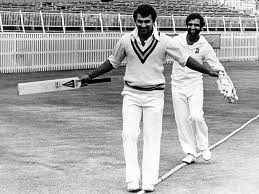The Asian Ashes
Gareth Bland |
The renewal of cricketing rivalry between Pakistan and India in 1978/79 came in the form of a series that had a transformative effect on both nations. At that point the two countries had not played each other for over 17 years, so the return of on-field hostilities was long overdue. With border and territorial disputes inherent in the structure of Pakistan since partition in 1947, the neighbours had been at war with each other twice since their last meeting with bat and ball. A whole generation of Pakistani and Indian cricketers had been unable, therefore, to pit their wits against each other. Now, nearing the end of the 1970s, that was about to change as a three Test series and 3 match one day international contest were scheduled to take place between the old rivals beginning in October 1978.
Indo-Pakistani relations were not the only backdrop to the renewed acknowledgment of each others cricketing existence. Packer’s World Series Cricket had split the previous Pakistani board and, embarrassingly, when the English tourists turned up in the winter of 1977/78, their objections to the presence of Packer players in the Pakistani squad forced the BCCP to renege on its promises of selection to the players who had flown in from WSC commitments in Australia to represent their country. A depleted Pakistan toured England in 1978 and was easily defeated by the home side. When it was clear that the India series would go ahead later that year both the Pakistani cricketing public and their estranged contingent of WSC contracted players realised the symbolism of the occasion. As Javed Miandad put it “a series that had been anticipated for seventeen years was not going to let anything stand in its way”. After arguing that “the contests are nothing less than an Asian version of the Ashes” Javed was open about the significance, to him, of an Indo-Pakistani rubber:
“They say the Ashes contests between England and Australia is the great cricket rivalry. That’s all very well, but what do you say about a cricket rivalry that’s based on a history of real war between two nations and where the blood spilt is still fresh? It is all about history.”
That said, the thorny issue of the Packer players and their return to the fold for this tumultuous clash had yet to be resolved. Step forward General Zia ul-Haq. Having deposed President Bhutto in 1977 and imposed martial law, General Zia became president in 1978. Dissatisfed with the equivocating of the BCCP during the previous year and anxious that Pakistan should be at full-strength, Zia dismissed the board and installed a new one which would operate under the stewardship of General Azhar. The ban on Packer players was lifted and so Pakistan would take on their neighbours with a side containing its best players. To put things into some kind of perspective, imagine, for a moment, there being no Ashes cricket following the triumphant return to England of Mike Gatting’s men in the early spring of 1987 until Michael Vaughan led his team out at Lord’s for the first Test in July 2005. Given what we now know about those 18 years, maybe, from an English perspective, that does not seem such a bad idea after all. In any event, after that long hiatus, both India and Pakistan braced themselves to make history in late 1978.
The build up in Pakistan was intense and the Indian tourists were met with a rapturous and warm welcome at Karachi airport on 25th September 1978. They had a stellar batting line-up: Gavaskar, his brother-in-law Gundappa Viswanath, Dilip Vengsarkar and the Amarnath brothers, Mohinder and Surinder. Three of the fabled spin quartet were still in operation, too: Bedi, Prasanna and Chandrasekhar had all made the trip. Less well known, though, was a 19 year old from Haryana in the far north, who, it was rumoured, could bat and bowl a bit. It was on this tour that the young all-rounder Kapil Dev would make his introduction to Test cricket.
Having been in Pakistan just a week, and with social and private functions galore, the Indian tourists took their international bow on 1st October in Quetta for the first of three ODIs. Chasing 171 to win Pakistan fell short on 166. From a position of relative comfort at 82-1 with Majid and Zaheer Abbas looking on course for victory the home side collapsed. Honour was restored in Sialkot less than a fortnight later as Pakistan ran through the Indian batting, dismissing them for 79. Pakistan reached their target for the loss of two wickets in the seventeenth over. With one ODI still to play between the second and third Tests, the whole of the subcontinent could now focus on the first Test in Faisalabad.
On 16th October Mushtaq Mohammed strode out to toss up with Bishen Bedi. Mushtaq, restored to the captaincy, elected to bat first. With Pakistan’s batting strength in depth and with the additon of their returning Packer glamour boys, there was still an inherent streak of conservatism when it came to pitch preparation, though. Rather than press home the advantage and focus on their own strengths, there was still an administrative cadre that would rather concern themselves with the perils that the oppostion might present. As Imran Khan noted:
“Sarfraz and I were amazed when we saw the pitch. There was not a blade of grass on it and it shone like a mirror. India did not have any pace bowling to speak of – Kapil Dev, who made his debut in this Test, was still an unknown quantity. When we enquired about the state of the wicket we learnt that the groundsman had been instructed not to provide any kind of surface that the Indian spinners could possibly use”
Despite the attempts to nullify the spin bowlers Pakistan were in the less than impregnable position of 110-3 by the first afternoon. Bedi, having accounted for Majid and Sadiq and Chandrasekhar, with the wicket of Mushtaq for just 5, had put the visitors in a prime position on a tense opening morning. What followed was a then record Pakistani partnership for Tests against India. Zaheer, majestically, and Javed, initially more cautiously, took on the spinners and Kapil Dev in a wonderful partnership of 255. Zaheer, with 24 fours and 2 sixes in his 176 showed the kind of dominance and mastery of strokplay that had earned him the sobriquet “the Asian Bradman” despite, oddly, having a poor home record up to this point.
According to his partner, Javed, Zaheer was so anxious to improve on this that he eschewed the possibity of taking strike at Chandrasekhar’s end. Chandra, at that point, had been turning the ball and was proving difficult to read, even for players of spin of the calbre of Javed and Zaheer. Prasanna, meanwhile, was the easier to read and score off. As Javed noted “Zaheer pulled rank and told me to stay away from Prasanna, whom he wanted all to himself. Instead, he wanted me to protect him from Chandrasekhar, whom he was finding a little difficult “. Whatever the dynamic between these two “big beasts” of the Pakistani batting line-up, they had batted beautifully in tandem. After Zaheer’s dismissal Javed went on and was still there as Mushtaq declared at 503-8. Miandad’s share was 154 and included 13 fours and 3 sixes.
In reply the featherbed pitch sapped the life from Pakistan’s bowlers as India racked up 462. The top five did their jobs with Viswanath taking the honours for his 145. Earlier, Gavaskar had made 89, his parter, Chauhan, 46, Surinder Amarnath had hit 35 and Vengsarker had partnered Viswanath with 83. Pakistan scored at just under 4 runs per over in their second innings as Zaheer narrowly missed out on another ton – this time he was dismissed for 96 – while Asif Iqbal hit 104. Needing an unrealistic 306 India closed on 43-0. Despite the draw the appetite had been whetted as thoughts turned toward Lahore and the second Test.
The second Test got under way at Gaddafi Stadium, Lahore, on a surface that must have made the hearts of Imran, Sarfraz and the veteran Saleem Altaf skip a beat. Opting to bowl first, Mushtaq hoped that his seamers would take advantage of the early favourable conditions. He was not proved wrong. As Wisden put it “the wicket was hardly fiery, but it provided enough movement off the seam for Pakistan’s pace attack to lay bare the Indian batsmen’s flaws in technique”. Sure enough all ten Indian wickets fell to seam in under 57 overs as they were dismissed for 199. Imran and Sarfraz utilised the conditions perfectly to pick up 4 wickets each, and Imran and his teammates were justified in their reading of the pitch when the all-rounder asserted “we knew that whatever life there was in the pitch would not last long in the heat”. Lahore’s October weather put paid to India hopes as a dry, unhelpful surface proved a paradise for Zaheer Abbas once more.
Perhaps even more commanding here than he had been in the previous Test, “Zed” hit 29 fours and 2 sixes in his 235. Around him Majid made 45 and Wasim Bari, coming in as nightwatchman, made 85. Late on in the piece, Mushtaq joined Zaheer in a partnership of 146. Eventually declaring on 539-6 Pakistan had scored their runs at 4.05 per over, a staggering rate for the times. As in the first Test at Faisalabad India’s top 5 all came good. Gavaskar and Chauhan opened with a 192 run stand although each was dismissed with a century in sight. With Surinder Amarnath scoring 60, Kapil Dev 43 and Viswanath, again batting sublimely, making 83, India looked in sight of saving the game. With the score on 406-4, however, “Little Vishy” was clean bowled by Mudassar, a dismissal which precipitated a collapse. Imran and Sarfraz returned to clean up India for 465.
Requiring 126 for victory in under 2 hours, Pakistan scored their runs at over 6 per over to win by 8 wickets. Asif Iqbal and Zaheer Abbas were out in the middle as the winning runs were scored. Such was the jubilation and relief that General Zia’s government proclaimed the next day a national holiday. There was still one Test to come, in Karachi, but everything seemed to bode well for Mushtaq’s team. Before the game in Javed Miandad’s home town, though, came the matter of the deciding one-day-international in Sahiwal. Relations between the two teams had been warm and congenial thus far. In Sahiwal, however, the mood was soured, thankfully only temporarily, by events at the end of India’s innings.
Chasing a none too imposing Pakistani total of 205, India appeared comfortably set for the win and the series. With three overs remaining in which to find the remaining 23 runs Sarfraz took the ball. With Gaekwad and Viswanath at the wicket the money would still perhaps have favoured India. In the gloom Sarfraz unleashed four consecutive bouncers. Incensed, Bedi called his men back into the pavillion and forfeited the match. For the Indian captain this was an uncomfortable throw back to the Caribbean tour of 1975/76 when he closed his team’s second innings with several of his players having retired hurt. On this occasion, although each delivery was out of the batsman’s reach, none was called a wide. When Bedi complained Mushtaq’s response was “they should send in taller batsmen so that the ball (sic) would not sail over their heads”. Bedi’s view of the incident chimes with a man whose cricketing credo was seemingley wholly at odds with the win at all costs doctrine that would become increasingly de rigueur:
“We were winning a one day match comfortably while the fear of losing had Mushtaq and his men resort to unfair tactics, where even a radar might have had difficulties in picking up the ball…the match tuned into a bloody military coup”
With the ODI series safely pouched by the home side the two teams converged on Karachi for the final Test. Winning the toss and electing to bat Bishen Bedi was indebted to a masterly 111 from Gavaskar who was sixth out at 217. Late hitting from Kapil Dev and Ghavri, the left-arm seamer, enabled India to post a respectable 344. Imran, with 3-75 and Sarfraz, with 4-89, were effective in spite of the conditions and not because of them. As at Faisalabad conservatism had trumped enterprise when it came to the choice of pitch. Imran observed that “two pitches were prepared in Karachi – a green one and a brown batting one. Amazingly, Mushtaq opted for the dead one to protect our lead”. In reply Pakistan slid to 187-5 despite an 84 run opening stand from Majid and Mudassar Nazar. Arriving at the crease at 155-4, and batting at number 6 since Wasim Bari had gone in first drop once more, Javed Miandad, still only 21 years of age, rescued his side with an even 100. This gave more than a patina of respectability to the total.
Pakistan’s score of 481 and lead of 137 meant that any hopes India had of at least salvaging a draw would be heavily reliant on the obstacle provided by Sunil Gavaskar. At the age of 29 this was a period in his career when he looked virtually impregnable when at his best. His one man show at The Oval in 1979 was still months away at this point, although here he was at times so commanding, so secure and seemingley without technical deficiency, that his batsmanship brings to mind the Indian observer who reckoned that, although Boycott rivalled hime for application and dedication, it was Gavaskar who had the edge due to his “greater natural endowment”. In Karachi, for the second time in his Test career, the future Sheriff of Mumbai made two centuries in a match. His 137 came to an end with his side 246-7, India eventually capitulating to 300. Gavaskar ended the series with an average of 89.40, almost double that of his nearest teammate, brother-in-law Viswanath. Earlier Mohinder Amarnath had joined Gavaskar in a partnershp of 117, at one point taking India to 122-1 before Amarnath’s dismissal. Imran, with 3-76 and Sarfraz, reverse swinging wonderfully with 5-70, turned the game for Pakistan. To win, and to send the whole of Pakistan into hysteria, required chasing down 164 runs. Somehow those runs had to be found from the final half hour of play plus 20 overs. Karachi held its breath.
After the early loss of Majid at 21, both Asif and Javed worked the ball around beautifully. When Asif was dismissed at 118 Imran was promoted to number 4 and effectively finished the game himself. Poor Bedi, trying to buy wickets, was struck for two sixes as Imran ended 31 not out while Javed, his partner at the other end, finished on 62. Incredibly, as in Lahore, Pakistan had done it again and had run out 2-0 victors in the series. Zaheer, watching from the pavillion during the run chase, commented years later “I remember most the running between the wickets between Javed and Asif – it was unbelievable. They were conjuring runs out of nothing and the Indians looked like they didn’t know what to do. There weren’t as many boundaries in the innings as you would expect. It was like one-day running but ahead of its time”.
It had been a thrilling series that had drawn these two old foes together in late 1978. After a 17 year absence the wait had been worthwhile. Despite the backdrop relations had been generally warm and cordial between the two teams, friendships emerging that would last beyond their playing careers. The mutual admiration and friendship that developed between Imran Khan and Sunil Gavaskar, for instance, was fostered during this series. Bishen Bedi, too, came to claim that he had “as many friends in Karachi as in New Dehli” and bows to nobody in his admiration for Imran Khan, the man he refers to as “General”. The series had touched players from both sides, Zaheer remarked of the final Test “It was amazing to be a part of something like that” as the crowd responded to Asif and Javed’s run chase. What, though, of the effect of the series on both teams?
Pakistan had been worthy 2-0 victors. A big name batting line up had been reliant on Javed, Asif and Zaheer with vital runs from Mushtaq and Imran later on in the order. Majid Khan, however, had looked like a fading figure; a victim, Imran feels, of his exposure to the Packer pace treadmill and his decision to quit Glamorgan. Imran was coming into his own as an all-rounder and the metamorphosis he had undergone in two seasons in Australia was evident in his more refined bowling action, courtesy of much hard work on his part and the tutelage of Mike Proctor and John Snow.
Sarfraz, then 30, was a man of guile and craft, the reverse swing he deployed at Lahore and Karachi proving instrumental in Pakistan’s victories. This may have been a team of “grandees”, to use Gideon Haigh’s description, but they could still be maddeningly inconsistent. Only a year later on the “cricket diplomacy tour” of India in 1979/80 they performed poorly under Asif Iqbal to lose the six Test series 2-0, with Zaheer at his wits end and averaging below 20. Reflecting on the ’78/79 Indian series Imran felt that he had witnessed a more accurate appraisal of the team’s batting strength in Australia during two seasons of WSC. Majid, Mushtaq and Zaheer had all looked vulnerable to the surfeit of pace served up down under; a million miles removed from the plunder of Lahore and Karachi during this series.
For India this series reflected generational shifts within the team both attitudinal, and in terms of the end of an eccentric and cultured epoch based around a quartet of spin bowlers. The Indian cricket writer Arunabha Sengupta has likened the demise of Chandrasekhar, Bedi and Prassana during the ’78/79 tour with the recent slow fade to retirement of VVS Laxman, Dravid and Tendulkar. He remarked:
“by the time the tour got underway, Prasanna was over 38. Bedi and Chandrasekhar were relatively young at 32 and 33 respectively, but given the fitness levels and training methods of the Indian team of the 70s, they had already stepped over the hill, and the descending slope would soon turn out to be spitefully steep”
Indeed, the second Test in Lahore proved Prasanna’s last, while Chandrasekhar played on until the 1979 summer in England and Venkat was recalled in 1983 for one final fling. Bedi, meanwhile, bowed out at the final Test at the Oval in 1979 as his arch-nemesis, Gavaskar, compiled 221. Bedi’s is probably the most interesting case of the four. Captaining the side from 1975/76 to 1978/79, his values seemed to belong to a gentler, more principled age. His objection to what he regarded as foul play in the Caribbean in 1976 and on this tour in the final ODI seem indicative of a soul convinced of the need for ethical conduct above and beyond the creed of winning at all costs. His less than friendly relations with Gavaskar during this series and beyond demonstrate two competing philosophies at work within the Indian game. As if to highlight this, Karsan Ghavri, Kapil’s seam parter in that final Test, argues that Bedi was pressing ahead in an attacking vein in the final Test when a draw was more than likely at the outset of that fourth innings:
“We could have easily drawn the game. But Bedi was trying to buy wickets, especially that of the in-form Imran, who was blasting the bowlers to all corners. There were no quotas in terms of how many overs we needed to bowl. Time was the prime factor – and we could have bought some had two fast bowlers operated from both ends. Sadly, our captain, Bedi, didn’t think so.
When Pakistan started their chase, their intention was never to go for the victory. But as the runs started coming, and with lots of wickets in hand, both Imran and Miandad started going for their strokes”
Evidently Bedi had wanted the win himself but it was in the means used to arrive at victory that he differed. He appeared to be bound by a different compact with the game itself; the desire to win by playing attacking – but fair – cricket.
Although the hand of Packer had not touched the Indian game directly – none of their players figured in WSC – the encroaching tide of materialism had washed up as far as Mumbai where Gavaskar would become entranced by its possibilities. Put simply, although Bedi remained captain during 1978/79 on the Pakistan tour, a new breed of younger players were coalescing around Gavaskar as a unit. When Bedi and his fellow partners in spin shuffled off the stage they left their nation’s cricket at the mercy of India’s magnetic poles: Gavaskar and Kapil Dev. What followed was a half-decade of pass-the-captaincy between the two, during which, incredibly, they managed to conquer the limited overs world in June 1983 at Lord’s. Accusations of self-interest would continue to be a bugbear, though; Dilip Doshi being just one player who would retire from the game disillusioned at his former teammates’ avarice. All this was some way in the future in November 1978, though, as the little Master proved himself the game’s best opening batsman and his young compatriot, The Haryana Hurricane, embarked on his Test career aged just 19.
Whatever the merits of Javed Miandad’s view that Indo-Pakistani contests represent the ultimate rivalry in international cricket, ahead, even, of The Ashes themselves, it is without doubt that the series of encounters between these two in the months of October and November 1978 represented a full-blooded alternative to the latest incarnation of the venerable old tradition which was about to take place Down Under that same Australian summer





Very nice read, Gareth.
Comment by chasingthedon | 12:00am GMT 9 March 2013
Brilliant article – thank you for contributing it. There are snippets of the series on youtube for anyone interested.
Comment by wpdavid | 12:00am GMT 10 March 2013
very nice read indeed
Comment by smalishah84 | 12:00am GMT 10 March 2013
Excellent piece Gareth – that series was certainly a deal better than the wars of attrition they had gone through in drawing ten consecutive Tests in 54/55 and 60/61 – on that latter tour not only were the five Tests all drawn but the other ten First Class matches on the tour were as well – the scoring rates were incredibly slow
Comment by fredfertang | 12:00am GMT 11 March 2013